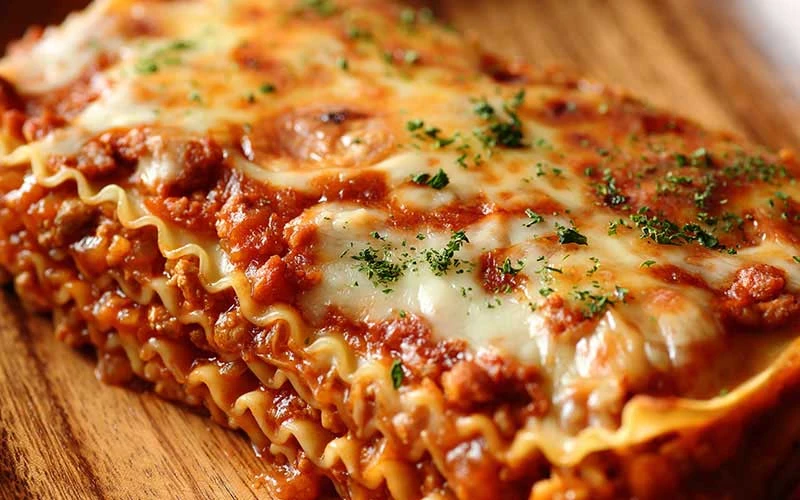zoomacademia.com – Lasagna is a beloved dish that has become a favorite in kitchens around the world. With its layers of pasta, rich sauces, melted cheese, and hearty fillings, this baked Italian classic is a true comfort food. Lasagna is versatile and can be made in many variations, from the traditional meat-based version to vegetarian, seafood, and even gluten-free options.
A Brief History of Lasagna
Though lasagna is widely known as an Italian dish, its origins can be traced to ancient Greece. The word “lasagna” comes from the Greek word laganon, which referred to flat dough strips. When the Romans adopted this dish, they adapted it into a layered meal with pasta-like sheets. However, it wasn’t until the Renaissance period in Italy that lasagna began to resemble the modern version we know today, with multiple layers of pasta, cheese, and sauce.
The dish became a staple in regions like Emilia-Romagna, where the use of fresh pasta, ragù (meat sauce), béchamel (white sauce), and Parmesan cheese took center stage. In Southern Italy, variations often featured ricotta cheese and tomato-based sauces, making lasagna a versatile and regionalized favorite across Italy.
How Lasagna Is Made
Lasagna’s hallmark is its layered structure, typically composed of three key elements: pasta sheets, sauce, and cheese. Here’s how a classic lasagna is built:
- Pasta Sheets – Lasagna is traditionally made with wide, flat pasta sheets, either fresh or dried. Fresh sheets are often thinner and more delicate, while dried sheets can be precooked or added directly to the dish if no-boil varieties are used.
- Sauces:
- Ragù (Meat Sauce) – A hearty meat sauce, usually made from ground beef, pork, or a mix, is simmered with tomatoes, onions, garlic, and herbs like basil and oregano. This sauce adds depth and richness to the dish.
- Béchamel – A creamy white sauce made from butter, flour, and milk. In some traditional Italian recipes, béchamel replaces or complements the tomato sauce, creating a creamy texture that contrasts with the pasta.
- Cheese – A combination of cheeses is typically used in lasagna, adding both flavor and creaminess. Parmesan and mozzarella are the most common choices. In Southern Italian versions, ricotta cheese is often used to add a layer of creaminess between the pasta sheets.
- Layering – Once the components are ready, the lasagna is assembled in layers: a base of sauce, followed by a layer of pasta, then sauce again, and topped with cheese. This process is repeated until the dish is full, with the final layer typically being cheese.
- Baking – The lasagna is baked in the oven until the top is golden brown and bubbly. The cheese melts, the sauces thicken, and the pasta absorbs the flavors, creating a deliciously rich and comforting meal.
Popular Variations of Lasagna
Lasagna’s adaptability allows for a wide range of variations, making it suitable for different tastes and dietary needs:
- Classic Meat Lasagna – Made with layers of ground beef or sausage, ricotta, mozzarella, and a rich tomato sauce, this is the most common version of lasagna.
- Vegetarian Lasagna – Instead of meat, this version uses layers of vegetables like spinach, zucchini, mushrooms, and eggplant. A tomato or béchamel sauce complements the vegetables, and ricotta or other cheeses can be added for creaminess.
- Seafood Lasagna – A luxurious version that replaces meat with seafood, such as shrimp, crab, or lobster, often paired with a béchamel sauce for a creamy finish.
- Lasagna Bolognese – A traditional version from the Emilia-Romagna region of Italy, made with a rich Bolognese sauce (meat-based) and layers of béchamel. It’s more delicate than some other varieties but deeply flavorful.
- Gluten-Free Lasagna – For those with dietary restrictions, gluten-free lasagna is made with alternative pasta, such as rice or corn-based sheets, without compromising on flavor.
- Vegan Lasagna – This plant-based option uses ingredients like tofu or cashew cream in place of cheese and meat substitutes for the filling. The sauce can be made from tomatoes, vegetables, or even a creamy nut-based sauce.
How to Serve Lasagna
Lasagna is typically served as the main course, often accompanied by simple side dishes like garlic bread or a fresh green salad. The dish is quite filling, so sides are usually light to balance the meal.
When serving, let the lasagna rest for a few minutes after baking to allow the layers to set, making it easier to cut clean portions. It can be made ahead of time and reheated, often tasting even better the next day as the flavors meld together.
Why Lasagna Is Loved Around the World
Lasagna’s universal appeal comes from its rich, comforting flavors and its ability to be customized to suit individual tastes. Whether you’re enjoying a traditional Italian recipe passed down through generations or a modern twist with new ingredients, lasagna is a dish that brings people together.
The comforting combination of pasta, sauce, and cheese has made lasagna a go-to meal for family gatherings, potlucks, and holidays. Its rich flavor, warmth, and hearty texture make it a perfect dish for feeding a crowd or indulging in a cozy night at home.
Conclusion
Lasagna is more than just a dish—it’s a symbol of comfort and culinary tradition. Its layers of pasta, flavorful sauces, and melted cheese come together to create a meal that satisfies the soul as much as the stomach. Whether you stick to the classic recipe or experiment with new variations, lasagna remains a timeless favorite that can be enjoyed in countless ways.







